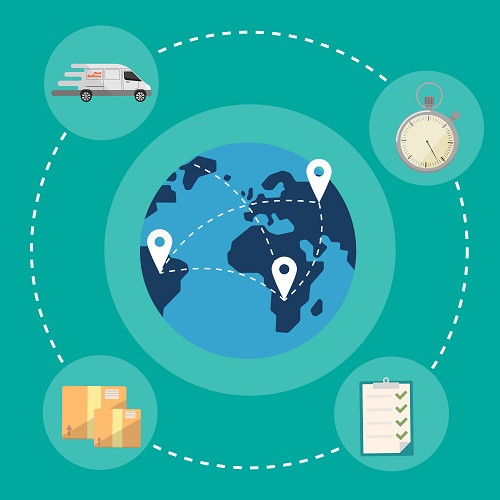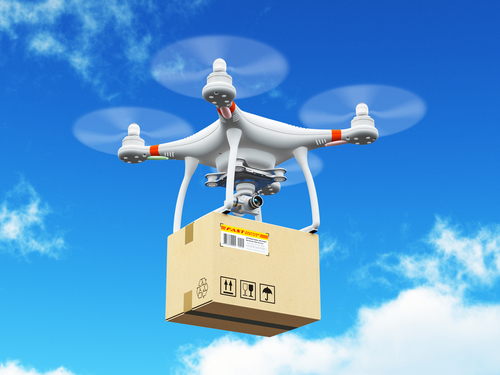Category: Logistics and Supply Chain
How Logistics Companies Can Gain Competitive Advantage with Customized Software Solutions?
Fluctuating consumer demands, increasing client requirements, and complex business models are posing critical challenges for logistics companies today. According to predictions made earlier this year, two major drawbacks are to be witnessed in the industry.
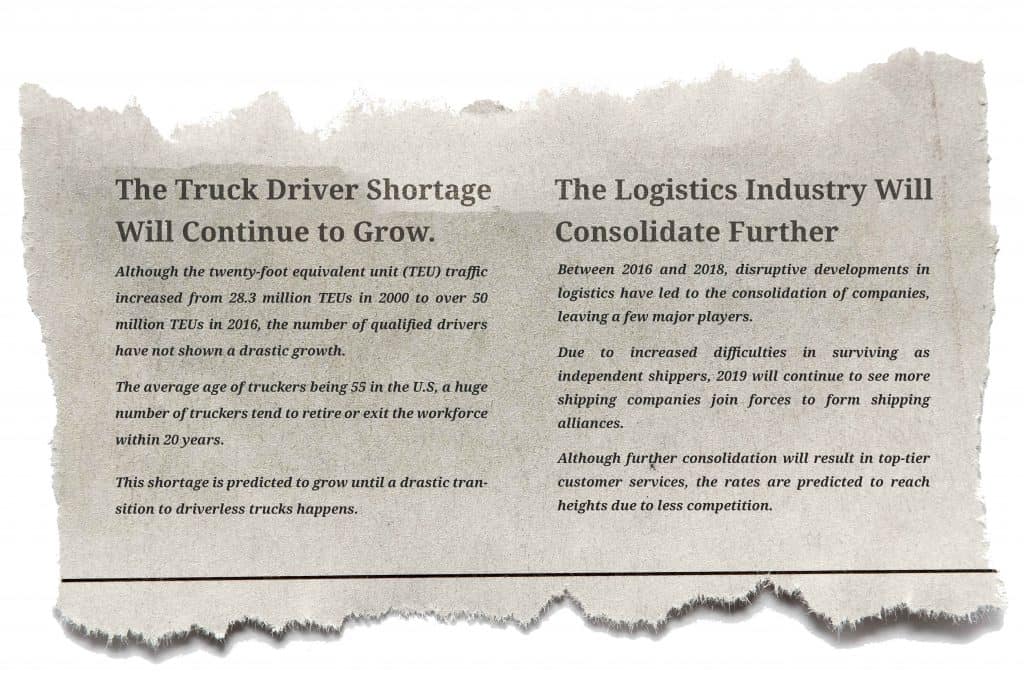
With drastic changes hovering over the logistics industry, the players are bound to stay equipped with the emerging technology trends, or they might get caught off guard. While its turning imperative for logistics companies to transform with smarter technologies, the question of whether to choose a custom software or an off-the-shelf package still lingers in many minds.
Why Choosing Customized Solutions Over Packaged Software Considered Profitable In Logistics?
Purchasing an off-the-shelf software would sound comparatively simple, stress-free and time-effective. But in the long run, it’s always a custom-built solution that pays off.
Most packaged logistics software, although sophisticated and deployed of disruptive technologies, pose standard solutions for the industry as a whole. Of course, they solve the major supply chain hassles. But with every business, possessing unique procedures, workflows, and objectives, “not everyone fits the same mold”.
So what happens when you choose a packaged software solution for your logistics business?
1. A packaged software often comes with hordes of features. This sure sounds exciting at the beginning. But when you have to pay for more than you use, it sure isn’t a happy moment! Off-the-shelf software solutions are often crafted considering the large players of the industry. Their features focus on resolving the common challenges faced by these companies.
However, in a complex industry like logistics, it’s not always necessary for every company to face the same kind of issue. Hence, with packaged software being available as a whole for a single price, businesses usually end up wasting money on features they do not need.
2. Off-the-shelf logistics software utilizes the latest and advanced technologies to cater to the complexities of an industry. But however, at times these sophisticated technologies complexes situations even further. For companies with basic knowledge on latest technologies, would definitely find it difficult to carry out operations successfully with a sophisticated system.
Moreover, they would have to spend extra time and money on training staff, which is not reasonable in a highly competitive industry like logistics. As mentioned before, with plenty of features, packaged solutions often prove to be less user-friendly and more complicated.
3. Although packaged solutions solve a list of logistics hurdles, their features might not provide a complete automated solution. You might find a good Transportation Management System (TMS) that enables real-time tracking and automated reporting, but you might still have to communicate with your customers, and assigned drivers manually.
Also, an efficient packaged TMS system might have an integrated warehousing management system, but might not facilitate an appropriate billing system, leaving the need to adopt alternate transaction processing systems. Hence, in a nutshell, complete automation is often unattainable with packaged software solutions.
4. The most eminent reason to not opt for a packaged solution is that they are rigid. There is hardly any packaged software company that allows customization. It’s not only rare to find a packaged software that caters to all your business-specific needs, but it also proves to be non-scalable in the long run.
Growth in your business and changes in the market will bring about an increase in your technology requirements. This will result in the need for a solution that can be customized with your growing business necessities.
Customized logistics software eliminates all the above-mentioned drawbacks of a packaged solution. Plus, it always comes with continuous technical assistance to simplify the technology transition in your company.
Let’s take a quick look at how a customized Transportation Management System can help you battle logistics challenges better.
Digital Transformation of a Logistics and Supply Chain Company – A Client Success Story
How A Customized TMS Can Enhance Your Supply Chain Efficiency?
Investing in a customized TMS can enable you to create an Uber-like platform for your logistics business. Integrating the latest in web and mobile application solutions, you can create a platform that completely streamlines your driver, client, and cash-flow management.
Enabling centralized data management, transparent billing, delivery match capabilities, along with real-time monitoring and customer insights capturing; a customized software solution can be framed to automate your entire end-to-end logistics operations.
A custom-built mobile application can further enhance productivity with less paperwork, better transparency, easy communication, and improved customer engagement. Implementing a customized solution would also let you add in innovative features that help you automate critical tasks, improve team collaboration, and increase your overall company efficiencies.
Here is a shortlist of benefits that you can acquire with customized logistic software.
1. A customized software solution gives the advantage of integrating with smarter technologies to simplify the minute challenges faced by the industry. For instance, along with assigning and managing truck drivers, a logistics company also faces difficulties in maintaining and verifying driver documents. Integrating with smart apps like Camscanner can simplify these documentation verification complexities.
2. A logistics company with varying client needs might often find difficulties in choosing apt carriers for a given order. A customized solution gives you the benefit to add in features that simplifies such decision making by suggesting the best available carriers for the orders.
3. Although packaged solutions streamline drivers assignment and management, yet they blackout on some eminent functions that logistics companies struggle to maintain. For example, calculating the detention hours/rates of the drivers are likely the most critical task of a logistics company. Through a customized logistics software you can straighten such bends of the industry.
4. With customized logistics software, a logistic company can embrace a completely streamlined and user-friendly accounting system that generates automated invoices as well as tracks any misleads or accounting errors.
Customized logistics software can simplify your logistics operations more than you can imagine. If you are looking for a tech partner to help you add in these features and more to your logistics software, then you have landed on the right page.
Fingent is one of the leading custom software companies providing advanced and user-friendly web and mobile technology solutions for logistics businesses worldwide. Contact us today to know how our custom software solutions can enhance your business abilities.
Stay up to date on what's new

Featured Blogs
Stay up to date on
what's new



Talk To Our Experts
Robotic Process Automation Reflecting The Banking, Insurance & Logistics Industries
Robotic Process Automation is the fastest-growing segment of the global software market. Using this technology, companies can fast-track their digital transformation initiatives. Although RPA is useful in all industries, the biggest adopters of this technology are banks, insurance companies, and logistics. These companies traditionally have numerous legacy systems and choose RPA solutions to enhance or replace manual IT processes. This article discusses how Robotic Process Automation is revolutionizing the banking, insurance, and logistics industries. First, let’s consider what is Robotic Process Automation.
What is Robotic Process Automation?
Robots have fascinated humans for a very long time. From the futuristic robot Maria from the movie Metropolis in 1927 to this day of AI sci-fi, the possibility with robots is a topic of endless discussion. Interestingly, though, this word “robot” in Robotic Process Automation (RPA) does not involve a physical or mechanical robot. Instead, it is a software running on a virtual or physical machine. Aaron Bultman, director of Product at Nintex simplified the expression saying, “RPA is a form of business process automation that allows anyone to define a set of instructions for a robot or ‘bot’ to perform.”
How to accelerate your business growth with Robotic Process Automation
According to Gartner, RPA grew by 63% in 2018 and continues to be one of the fast-growing technologies in many industries! RPA lets companies automate current tasks as if a real person was doing them across systems and applications. It interacts with each system just as a human user would interact. This does not require complex system integration. These functional RPAs are virtual workers and execute rule-based information processes, enhancing efficiency and accuracy. Additionally, it is easy to model and deploy. Let us consider the three specific industries where RPA is most beneficial.
RPA in Banking
The banking industry is completely process-oriented. Every activity is done meticulously to avoid errors in processing. The repetitive nature of the job and the high probability of human error could cause mistakes that might prove very costly. Therefore, in the recent past, leading banking institutions have started using RPA to minimize errors. According to a report by KPMG, RPA will perform almost 75% of the existing offshore jobs, which could save operational cost.
Scalable Benefits of RPA in the Banking Industry
- Mortgage Lending. RPA can enable the banking industry to meet loan quality and cost concerns head-on. Automation of repetitive and time-consuming manual tasks will free up your team to focus on the more important details of loan applications. It speeds up the work, increases revenue. enhances customer experience, reduces operational costs, decreases risk and improves compliance.
- Compliance and Risk Management. It enables the banking industry to automatically integrate and aggregate compliance information into business processes, streamlining the required work while reducing expenses. RPA eliminates the need for manual regulatory monitoring and data collection. It can empower risk management and compliance teams. It enables banking industries to avoid costly fines and damages to reputation. It provides accurate and complete information.
- Customer Service and Support. RPA ensures the longevity and loyalty of your customer relationship and the future of your bank. It helps you engage customers in real-time. It automates customer service activities so the customer is not waiting endlessly. It increases the productivity and efficiency of the team.
Related Reading: Check out these 5 simple hacks on using banking mobile apps safely.
RPA in Insurance
An insurance company receives hundreds of claim requests. Validating each request and handling them is not only a herculean task but also a painstakingly slow manual process. The entire process of the claim takes several days. Because this is a costly and time-consuming process, the company risks losing customers. To prevent further damages, insurance companies are now relying on RPA to help them improve operational excellence and reduce costs.
Scalable Benefits of RPA in the Insurance Industry
- Improves customer service because RPA effectively reduces the turnaround time in resolving customer issues.
- Processes and workflows could be tracked and recorded at each phase. This reduces staff workloads and improves process efficiency.
- Reduces the processing time by 40-80%. This frees up the team to focus on more important activities such as acquiring new clients.
- Reduces errors made during data entry significantly.
- Speeds up and organizes the processing of claims through a systematic underwriting process.
- Based on the demand, intelligent bots can scale up or down, which delivers consistency in service and operational efficiencies.
- Improves audibility and operational risk management due to the accuracy level of RPA.
- The time for the cancellation process could be reduced by one-third.
Related Reading: Here’s how machine learning is accelerating paperless offices for legal firms.
RPA in Logistics
The logistics industry depends on several processes to facilitate the proper distribution of products, materials, and services from B2B or B2C. The need for an intelligent logistics system increases as the industry along with competition advances every day. Here’s how the RPA can contribute to the logistics industry:
Scalable Benefits of RPA in Logistics.
- Better data management and customer service. Negative experiences and a multitude of errors with logistics providers are causing customers to lose their trust in online shopping. With the benefits of automation and digitalization brought about by RPA, logistics providers no-longer need to rely on huge amounts of paperwork, which was the underlying cause for errors and poor customer service. Logistics companies are enabled to manage real-time monitoring of flow and resources, availability, costs, staffing, transportation, suppliers and so on more efficiently.
- Improved work safety for employees. Through the use of automated machines in unsafe environments and the reduction of repetitive stress in manual tasks, work injury has been dropping steadily with the aid of RPA. This results in savings in terms of injury compensation and loss in reputation. It can also increase productivity, improve employee satisfaction and loyalty, and increase their efficiency.
- Improved efficiency and precision. RPA can help logistics companies easily manage the supply chain processes more efficiently. The anticipatory logistics system helps companies gauge the demand from their customers and adjust their production volume accordingly. It can help in managing and analyzing huge amounts of data within seconds, resulting in fewer human errors, faster deliveries, and fewer errors in delivery.
- Cost reduction. Fewer errors from human decision-making result in cost savings for logistics companies. Also, RPA reduces the need for human workers, which results in fewer paychecks and more profits. Where workers are still needed, it can raise their productivity, margins to a whole new level. It improves customer satisfaction and creates a safer work environment for the workers.
Related Reading: Know more about how AI is reshaping the supply chain and logistics industry.
Empower Your Business With RPA
According to Global Market Insights Inc., the RPA market is expected to reach $5 billion by 2024. It is increasing capabilities and improving performance while reducing costs in several industries. Fingent Technologies has been one of the top software companies empowering industries globally with robotic process automation capabilities. Give us a call and let us discuss how we can transform your business with RPA.
Stay up to date on what's new

Featured Blogs
Stay up to date on
what's new



Talk To Our Experts
Logistics is a precision business, where success depends on making accurate moves at the right time. A high level of contextual awareness, backed up by highly optimized processes are the essential ingredients of success. Efficiency is the end result, which comes as a result of such heightened levels of workflow optimization, allowing companies to streamline their logistical operations right from its core. Here are five trends logistics managers need to co-opt to their business immediately, for success in a highly competitive and challenging business environment.
Related Reading: Having a clear picture of the challenges involved in logistics management will give you an overall insight into the industry. Read on to know more about it here.
1. Warehouse Majors Invest in Automation in a Big Way
Today’s business has increasingly become fast-paced. Highly demanding customers seek instant gratification on one side, and businesses, in a quest to do more with the finite resources on hand, try to optimize and accelerate their supply chain, on the other side.
All this means not just larger volumes to process, but also a significant increase in the number of issues warehouse and logistics management needs to deal with in a day. Side-by-side, competitive pressures mean wafer-thin margins, leaving warehouses bereft of the luxury of spending more to cater to the increased workload.
The solution to overcoming such challenges is automation.
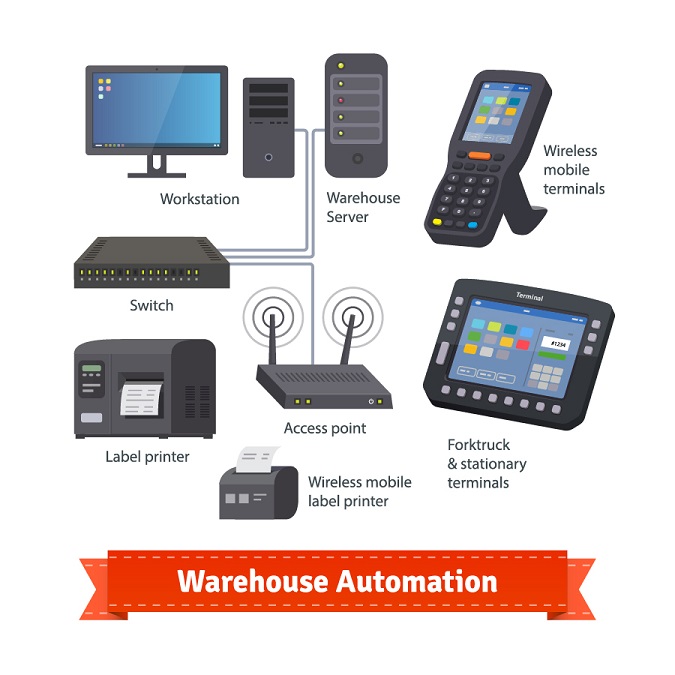
The single biggest task for warehouse executives is determining fleet deployment, matching fleet deployment with cargo based on loading capacities, fuel consumption, and more. Another critical task is monitoring fleet movement.
Automating these functions, by using the latest software to intelligently route different data sets and data streams improve accuracy, leaving the managers free to focus on other things where their core competencies and interventions would be more productive. Such warehouse automation solutions improve the efficiency, accuracy, and velocity of warehouse operations manifold.
Major logistics players are already adopting warehouse automation in a big way to move things. Amazon’s KIVA robots grab items from shelves in a highly efficient manner, and its yet to be released automated drones will deliver items to addresses within 30 minutes of an Amazon center.
Uber, Waymo and other companies are already undertaking successful test-runs of self-driving vehicles such as cars and trucks, indicating the shape of things to come.
Related Reading: Understand more about how emerging technologies like AI continues to redefine the logistics and supply chain industry here.
2. Logistics Providers Make Better Decisions with Big Data
Big data analytics unlock a wealth of possibilities for enterprises. For logistics companies, insights from big data are invaluable in optimizing routing, identifying perennial bottlenecks in the supply chain, and streamlining the flow of goods and resources at the warehouse.
Real-time traffic, climate, and other data could identify the best route to a destination, factoring in route congestion, diversions, fuel prices, and much more. Predictive analytics help identifies whether the addressee is likely to be at home to sign for the shipment, avoiding repeat visits, and more.

Logistics major UPS saves 10 million gallons of fuel and emits 20,000 tonnes less carbon dioxide, while delivering 350,000 more packages every year, ever since they started to apply big data analytics in their routing.
Several logistics players use big data analytics extensively to improve last mile delivery. The last mile of the supply chain is known for being inefficient, and cost up to 28% of the overall delivery cost of a package. Logistics players may apply big data to unearth patterns at play to optimize delivery routes and strategies and identify the best delivery modes and time for any specific address.
A whopping 98% of 3PLs regard improved data-driven decision making as essential for successful supply chain activities and processes.
Related Case Study: Restructuring of existing processes centered around an enterprise mobility solution has become the need of the hour. Know more about how we helped a logistics company streamline and restructure their processes to facilitate better communication and drastic speed improvements.
3. Omni Channel Logistics Facilitates Smarter Deliveries
Today’s consumer journey typically moves across channels, based on their preferences. The various channels operate independently, and even as businesses try to optimize the experience across the various channels, variation in service levels, pricing, and customer experience, are inevitable.
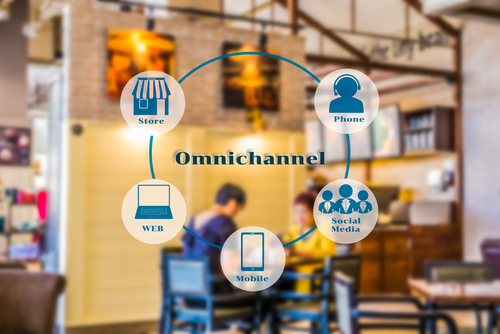
The omnichannel approach entails convergence of the hitherto separate channels into a single seamless channel, using a central hub to route all movements, and using different channels for delivery, as appropriate. The orchestrated product flow delivers a highly personalized shopping experience. However, delivering a consistent customer experience across different channels is challenging, and makes the omnichannel approach more complex than the multi-channel approach.
Effective knowledge sharing on a real-time basis is critical to the success of the omnichannel approach. A critical requirement towards this end is transparency, to make explicit the status of the inventory and shipment in real time. Significant effort and investments to create cross-channel visibility and establish sound business rules are essential prerequisites, as is a warehouse management system (WMS). Different stakeholders in the ecosystem, such as logistics provider’s, warehouse, and shipping service usually have their own WMS, accessible by the logistics provider through a portal.
4. Making Collaboration Work
The role of robust collaboration can never be understated, especially in today’s supercharged business environment where tasks are complex, speed is of the essence, and any delays can have huge implications, if not lost business. Moreover, the supply chain is now increasingly becoming global, and no single stakeholders can realistically hope to cover all ground. In such a scenario, successful supply chain relationships deliver not just economic conveniences and cost efficiencies, but also the ability to meet customer demands in double-quick time, and realize agility in business operations.

In fact, successful collaboration can make the difference between long-term sustainability of the business and short-run dissolution. As competition increases, supply chain partners are toying with several innovative ways to make collaboration work for mutual benefit. Such innovations may take the form of new products or processes, but needn’t always be big breakthroughs. It could also be innovative combinations of existing tactics, relevant for the specific market.
5. Moving to Service Chains
A supply chain is an ecosystem of people, enterprises, activities, information, and resources, working in a coordinated way to move the product from one stage to the other, from supplier to the customer. However, a well-oiled supply chain, though indispensable, is no longer enough in today’s highly competitive business environment. Businesses are forced to focus on strategic quality management, aimed at re-engineering inefficient work processes and continuous quality improvement of existing processes.

The complexity of the supply chain is in direct proportion to the complexity of the business. The overriding aim of moving to service chains is to reduce such complexities and ensure faster and efficient delivery of services, which would contribute to seamless supply chain operations. Ways to achieve such a state include setting up of a network of strategic centers facilitating same day deliveries, deploying intelligent warehouse automation solutions for forecasting and planning, instituting a comprehensive supply chain technology encompassing all bases, and more.
Doing so requires a sound technical partner to deliver warehouse automation solutions, and other supply chain technology to further supply chain efficiency, crunch big data, and more.
https://www.youtube.com/watch?v=j6bcsYhejy8
Digital Logistics and Supply Chain Trends [Source:SAP]
Stay up to date on what's new

Featured Blogs
Stay up to date on
what's new



Talk To Our Experts
Top Challenges Logistics Managers Face Everyday
In the present scenario of global economics, logistics play a key role in facilitating trade and, by extension, ensuring the success of business operations. However, changing consumer demands, complex business models and growing client demands are just some of the top factors that pose a challenge in streamlining logistics management. So, how can logistics management personalize a conventionally standard service? Well, that is perhaps the top challenge that the industry has been facing in the last few years among others.
In their struggle to ensure optimum results, here are the top challenges faced by logistics managers today:
-
Cutting Transportation Costs
Growing fuel prices increased wages, and peaking inflation indexes all work in tandem to increase transportation costs daily. Cutting a few corners here and there does not always help in meeting the cost-cutting goals for transportation. Adopting a strategic approach to eliminate or reduce bottlenecks can prove pivotal in revamping network designs and consequently cutting down on transportation costs.  To implement these strategies well, logistics managers need reliable information on existing and future orders. Using a visibility software can help in simplifying these challenges. For a small business, relying on a cost-effective third-party transportation agency that caters to air, ocean, rail and road transportation is sometimes the best bet for accessing quality services in a cost-effective manner. For one, it rules out the added expenditure of maintaining a fleet of delivery vehicles, paying salaries to the transportation staff as well as dishing out freight charges and other taxes. You just pay a lump-sum to an expert third-party and they take care of the rest.
To implement these strategies well, logistics managers need reliable information on existing and future orders. Using a visibility software can help in simplifying these challenges. For a small business, relying on a cost-effective third-party transportation agency that caters to air, ocean, rail and road transportation is sometimes the best bet for accessing quality services in a cost-effective manner. For one, it rules out the added expenditure of maintaining a fleet of delivery vehicles, paying salaries to the transportation staff as well as dishing out freight charges and other taxes. You just pay a lump-sum to an expert third-party and they take care of the rest.
Related Reading: Take a look at how a Transportation Management System can ease out the challenges of a 3rd party logistics service provider here
-
Processing Enormous Amounts of Information
Logistics managers have to deal with a lot of figures and data on a daily basis, besides coordinating smooth discharge of operations. The scope of their work includes ensuring the safety of the fleet and staff, fleet loading, cross-checking route maps, sanctioning fuel bills and so on. When done manually, this can be a time-consuming and tedious task that can take your focus off from attention to details. Investing in an automated solution or application for data entries, fuel bills, loading and unloading ledgers can go a long way in streamlining operations by allowing logistics managers the luxury of time to look at the finer nuances of operations.
-
Offering Segmented, Customized Services
Thanks to globalization, logistics management is turning into a multi-layered job where managers are expected to keep tabs on multiple supply chains simultaneously. You don’t just need to deliver goods on time but also offer customized services to different suppliers and customers in terms of packages and pricing. With the increase in customer expectation, some top rated shipping companies are striving to consistently provide maximum consumer satisfaction. A study by statista shows the 2017 and 2018 American customer satisfaction index (ASCI) scores for consumer shipping companies in the United States.
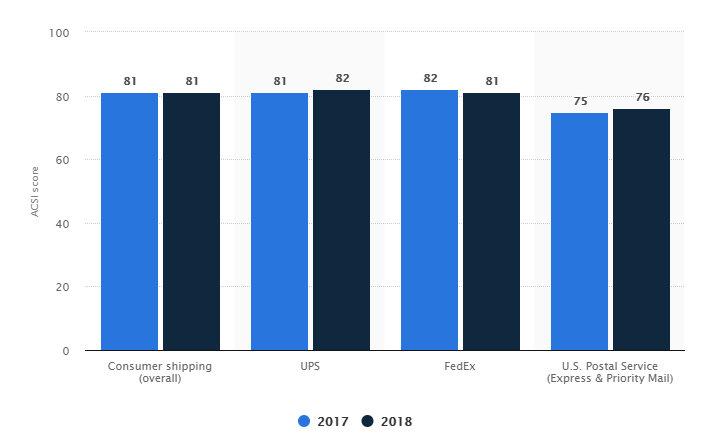
The keyword for success in this scenario is flexibility. Logistics operators need to offer personalized experiences to multiple segments of customers. Using a logistics management software that can automate the process of projecting different services to different customers can not only save time and effort on the managerial level but also bring added accuracy to data compilation and compliance.
Related Case Study: A constantly growing market like logistics cannot be managed only from a single device. How mobility solutions can ease logistics management and reduce its challenges is a read worthwhile. Find out more on iOS and Android development for logistics and supply chain company.
-
Manpower Management
Manpower is the trickiest of management responsibilities. You must maintain a humane approach toward the employees while keeping the best interest of your organization in mind. That can be a complicated equation in any managerial setup, but especially so in case of logistics management, as the drivers and staff are often placed in different geographic locations to maintain swift supply chain velocity. Decentralization of responsibilities, by appointing logistics managers in key locations, with appropriate work-order management solutions can help in more efficient management. For instance, work order software like ReachOut, helps logistics managers manage team utilization, team schedules, show proof of work, generate quotes and invoices and do much more. Managers can easily keep everyone on the same page and notify the staffs immediately about changes or provide them with live info they need.
The future of supply chain management How will technology and AI shape tomorrow [Source: University of Liverpool Online]
-
Compliance with Regulations
Transportation rules, regulations and security norms can vary from city to city, state to state, and quite obviously, from country to country. If you are a business catering to a global clientele, keeping up with these varying rules and regulations and familiarizing your staff with these, can pose a grave challenge. Collaborating with an efficient audit software can help eliminate these pains and improve your compliance, audit results and lead to quality investigations, thereby saving you from the trouble of getting on the wrong side of the law.

With the landscape of business operations continually changing, there is a shift in the ensuing challenges as well. Staying abreast with these changes and taking preemptive measure to ward off these challenges, is a sign of sound logistics management. However, solving logistic issues is not an impossible mission. Focusing on 3 major factors- Data, Process and Technology, can solve the biggest challenges of logistics.
For prompt and apt logistic solutions and to enhance your technology adoption in logistics, get in touch with Fingent now!
Stay up to date on what's new

Featured Blogs
Stay up to date on
what's new



Talk To Our Experts
Computers are getting faster and smarter with each passing day. It has been spearheaded in a direction where computers are taught to mimic natural human intelligence, a concept and now a reality known as Artificial Intelligence (AI). Since its coinage in 1956, AI has been predicted to lead computing for automating and substituting all human processes, particularly in the industry and commerce.
Processes like supply chain management, which needs relentless focus and labor in all its operations can benefit deeply from the use of AI. With the developments in AI moving at breakneck speed, companies have already invested in AI for managing their supply chain. The result is complete automation from production to delivery along with an overall improvement in efficiency and speed.
The application of AI has made the entire process of supply chain management more streamlined and accurate. It takes human labor out of the process, which is one crucial aspect companies look forward to reducing costs and errors. Meanwhile, AI is proving advantageous to other areas of supply chain management as well, which resulted in more companies adopting it into their workplaces.
Let’s digress a bit to talk about what artificial intelligence is about. Artificial intelligence is about taking the capabilities of Machines in terms of Intelligence beyond the monotonous processes, and adding a dash of autonomy to the decision-making capabilities. The advent of artificial intelligence has expanded the capability of automation and technology and has forayed into a Territory of operations that was once reserved only for human beings.
When it comes to the application of artificial intelligence, many industries and segments have benefited from it. One among those is the domain of supply chain management. Supply chain management is gaining importance by the day going to the disappearance of Geographic and physical borders when it comes to transactions.
As inferred by Gartner, the application of artificial intelligence in the field of supply chain management can be broken into two categories:
Augmentation: 
Augmentation is really a sophisticated word for addition. Artificial intelligence is seeing its uses even in everyday activities like setting an alarm using personal assistant like Google Assistant or Siri. This kind of Artificial Intelligence can be used in spaces where the guy does not have complete control over the outputs, but rather augments the human effort with some intelligence that needs to be essentially gathered from monotonous tasks.
AR has transformed the software used in supply chain management. AR help truck drivers, warehouse workers, and management keep track of products by overlaying information onto the real world. Augmented reality is used efficiently in “pick and pack” service. In a large warehouse, AR enables to locate products easily and pack them. Logistics robots can easily scan a product for damage, check its weight and adhere to package shipping instructions.
Automation:
Automation seems to be the password in every industry. There are certain instances where the process is so simple that Artificial Intelligence can take over the entire process including the final output. This completely eliminates the need for human intervention. With this elimination of human intervention, the probability of error is also greatly reduced. One fine example would be the implementation of robots in performing a few key steps when it comes to the manufacturing industry.
The future of supply chain management How will technology and AI shape tomorrow [Source: University of Liverpool Online]A few specific aspects in which Artificial Intelligence can assist in supply chain management are:
Using chatbots: 
We have been using the internet as a communication medium using instant messengers for a while now, and the conversation generally starts with a templatized set of questions. These templatized questions and the conversations surrounding them can be automated using a chatbot. Chatbots help in streamlining the procurement related tasks through automation and augmentation. These chatbots can be used to help with the initial steps of procurement. The information that we receive from this chatbots could also help determine the validity of the leads.
Chatbots can be used to automate numerous tasks especially in communicating with the customers via direct calls or text messages. The advancements in chatbot programs have enhanced their communication abilities, which have made them useful aids for a variety of tasks besides answering calls or queries. Most chatbots are able to place purchase request, conduct research, answer questions, file and document invoices alongside communicating with the customers.
Supply chain planning and machine learning:
Machine learning is the technological twin of artificial intelligence. Intelligence can only be achieved by learning, and if machines have to be intelligent, they have to learn automation. Supply chain management can incorporate machine learning, even if not for execution, at least for planning. Machine learning can help in a variety of aspects in supply chain planning.
Machine learning can help with the forecasting of inventory based on demand and supply. Facilitating the machine to learn with the right segments of data could also bring in a revolution in terms of agility and optimization of even the decision making processes in supply chain management. Teaching the human beings something is an arduous task -stitching machines the same thing only makes it a little bit more challenging. However, you can expect the Machines to learn things a bit faster and get more accurate with the time then you can expect human beings to be!
Machine Learning for Warehouse Management: 
Warehousing is an integral part of any Logistics Company, and it requires a good understanding of the inventory, the demand, the supply and the challenges in facilitating a smooth transition between the two ends to be successful in the field of Logistics.
Machine learning and artificial intelligence come in handy at this juncture, because the planning and Management for warehousing depend on the intelligence that can be gathered from the data. The data can analyze vital pointers, including the supply floors like overstocking or understocking, and even the kind of inventory that we are looking at, including the attributes of longevity and susceptibility to damages when in storage.
Natural Language Processing for Data Sanitization:
The last couple of aspects that we have been looking at talks about data point data is very important to make calculated decisions. If the data is not like it, the decisions might not serve the purpose of being beneficial for the business. Therefore, it is essential to ensure that the data is clean and business-worthy.
Natural Language Processing, commonly abbreviated as NLP, is an element of artificial intelligence that takes care to decipher foreign language data, and streamline them in a way that it can be used for data processing. With the humongous amounts of data that the logistics industry Encounters, it is important to sanitize the data before it can be used to make important business decisions. The aspect of Natural Language Processing develops with Machine Learning and artificial intelligence.
Related Webinar : Artificial Intelligence in layman’s termsAutonomous and Self-Driving Vehicles:
Thanks to the innovations by Elon Musk and the automobile company Tesla, self-driven cars are no longer an element of science fiction. Self-driving vehicles have started to take over the realm of montane transportation. If there is one territory where this advancement can make a significant impact, it has to be in the field of logistics and shipping.
Driverless trucks might be in the nascent stages of development, but the progressive only point towards a positive conclusion. If driverless trucks are introduced, it can overcome a lot of hurdles, especially with respect to the mandatory crest that humans require. The laws in most of the countries mandate that drivers can only engage in 11 hours of break-free drive. With driverless trucks stepping in, the driving can go on effectively for 24 hours, and it will definitely reduce the cost by at least 25%.
With the advent of e-commerce on both B2B and B2C fronts, logistics is only gaining more importance by the passing day. A lot of eCommerce companies depend on the data from the logistics service providers to make more calculated decisions. By incorporating the latest in the world of Technology like the concepts of machine learning and artificial intelligence, it would not be right to say that the logistics industry would be far ahead of its time, because, in today’s world of rapidly changing advancements, it is important to be technologically advanced to even stay in the race!
Stay up to date on what's new

Featured Blogs
Stay up to date on
what's new



Talk To Our Experts
Here are 8 ways how a good transportation management system could make a difference to your business if you are a 3PL or NVOCC operator.
With the expansion of world trade and multinational business activity, more and more organizations are keen on operating globally and making their presence felt in the global market. Transportation and logistics play a huge role in helping such organizations expand their business and establish new business relationships. Large businesses prefer building their own teams to handle their supply chain & logistics requirements.
However, research reveals that more than 80 percent of all Fortune 500 and Fortune 100 companies use some form of 3PL (Third Party Logistics) services to handle their logistics and supply chain processes. This is because third-party logistics providers usually have a huge network, which offers a competitive advantage over in-house supply chains. Outsourcing logistics also help the organization by saving time, effort and money involved in maintaining the in-house logistics process.
3PL is, therefore, a highly competitive market and providers must compete to win and retain their clients. Providers typically specialize in transportation, warehousing, order management and other integrated services, which can be scaled or customized to meet the customer’s specific need.
Challenges faced by 3rd Party Logistics Service Providers
Time Constraints
Effective utilization of time is one among the most critical factors that determine the success of any logistics service provider. 3PL providers should be able to support customers by minimizing the inbound lead time, i.e., the amount of time taken from the point of placing an order to the point the shipment is received by the customer. To achieve this, providers should be able to effectively communicate and coordinate with the shipping agents, transport carriers, customs agents, etc. on a prompt and timely basis.
Lack of Infrastructure
Lead logistics providers are 3PL providers without their own assets, who have specialized industry expertise along with low overhead costs. However, they have lower negotiating power since they have with them fewer resources to offer compared to other service providers in the market. In such a situation, the success of the 3PL provider depends on their ability to partner with independent transport carriers and offer competitive rates to customers.
Documentation
It is a difficult task for small and mid-sized 3PL providers to keep track of information related to all their shipments. There are different types of documents involved in international trade transactions. These include purchase orders, bills of lading, air waybill, cargo insurance certificates, commercial invoices, packing lists, delivery note, certificates of origin, dock receipts, export licenses, etc.
Management of transport documents is a challenging task due to the administrative process involved, large volumes of documentation, transfer of the document and ownership of goods from one party to another. Logistics service providers must ensure that the right set of documents are transferred between the shipper, consignee, notify party, transport carriers and other parties involved in the transaction.
Lack of Reporting Systems
In most cases, the upper-level managers working with 3PL service providers and Non-vessel operating common carriers (NVOCCs) tend to focus on their core activity of transportation and logistics management. This leads to situations where they do not have enough visibility or insight into the other functional areas of their business. Depending on the size of the business, poor management of the business processes and resources could result in the loss of up to hundreds of thousands of dollars each year.
Benefits of a Transportation Management System (TMS)

3PL providers could utilize transportation management systems to refine their existing processes and improve overall efficiency. There are many ways of automating the logistics process, including tracking and monitoring each delivery. Some of the key features offered by Transportation Management Systems include:
Order Management
Transportation management systems help logistics service providers (LSP) to streamline their order management process by integrating their ERP and distribution modules. This adds a lot of value to LSPs, especially in situations where they have to manage large amounts of shipment or order data from multiple sources. It also offers customers the ability to track the status of their orders or shipments.
Document Management
Supply chain transactions involve various sets of standardized documentation flowing from the buyer to the seller, documentation required for trading or banking requirements, and also by customs authorities. In case the shipper, consignee or notifying party does not have a dedicated team to handle their supply chain & logistics process, LSPs play a vital role in managing the documentation and supporting them in complying to commercial laws like the Incoterms. Transportation management helps in automating the documentation process and allows for the generation and transfer of shipping documentation using the system.
Electronic Data Interchange (EDI)
EDI has become a crucial part of modern business, allowing for the electronic exchange of business documents between trading partners. It helps service providers to communicate with their trading partners and electronically transfer documentation like purchase orders and invoices. EDI solutions help by leveraging various transaction sets like:
- 204 – Motor Carrier Shipping Information: Used by shippers to tender an offer for a shipment to a full truckload motor carrier.
- 210 – Motor Carrier Freight Details and Invoice: Sent from the carrier to a shipper, consignee or third-party payment center for payment of freight charges.
- 214 – Motor Carrier Shipment Status Message: Used by transportation carriers, such as trucking companies, to provide shippers and consignees with the status of their shipments.
- 990 – Response to Load Tender: Used by motor carriers to indicate whether it will pick up a particular shipment previously offered by the shipper.
- 997 – Functional Acknowledgment: Serves as a receipt, to acknowledge that an EDI transaction or a group of transactions was received by the remote party.
Rate Sheet Management
Freight rates are made up of a complex combination including the type of load, base rate, surcharges, equipment charges and other additional charges. Cargo may be transported in various loads depending on the mode of transportation, for e.g., as FCL (Full Container Load) or LCL (Less than Container Load) in case of sea freight. Each mode of transportation could, therefore, have an implication on the rate of the shipment. Transportation management systems help LSPs to create rate sheets for the specific service they offer and assign them to a customer or vendor based on the contract and rates agreed. Shippers can access the system at their convenience and manage or review the applicable rates before they place the order.
Dispatch Management
Dispatch management provides the capability to dispatch, deliver and track shipments. It allows LSPs to track the shipments, review driver activity, locations of pickup and delivery, manage load types like FTL or LTL, split trips, etc. A good dispatch management software could help LSPs to consolidate shipments from various customers and review the dispatch process handled by different vendors, which in turn saves a lot of time. It offers a business opportunity for owner-operators and independent drivers, to engage with the 3PL or NVOCC provider and track their upcoming, ongoing or previous shipments by using the service providers system.

Fleet Tracking
Smartphone-based GPS-tracking systems provide logistics service providers, especially trucking companies, with real-time information regarding their shipments. 3PL and NVOCC operators will be able to track the location of trucks managed by their vendors and assign shipments or orders to the relevant trucks based on their GPS location and route.
Warehouse Management
Warehouse management systems allow 3PL companies and NVOCC to manage customers, processes and billing schedules. The system enables access to real-time information and provides integrations with warehouse management technologies, including e-commerce shopping carts and QR or barcode scanning. The software also helps operators to manage different stock levels in warehouses, streamline the supply chain process, and satisfy customers by keeping them updated and informed on the status of their cargo.
Data Warehouse ETL and Reporting Tools
Logistics service providers have to handle large amounts of data related to shipments, their weights, sizes and contact details or returns on a regular basis. This leads to an incredible amount of information over time that has the potential to be analyzed for identifying business trends. This, in turn, could help the service providers to take important business decisions based on real-time data. It would also help conduct detailed cost-benefit analysis to improve profitability and optimize on-time deliveries to ensure customer satisfaction.
Timely and reliable delivery can mean the difference between repetitive business and a one time sale. Hence, the ability to plan, optimize, execute, analyze, and react to every logistics requirement is a critical factor that determines the success of any 3PL provider. Transportation Management Systems help 3PL providers to streamline their business processes and resolve any operational challenges that they are facing. It provides a competitive edge and improves their ability to manage and dispatch orders, with a lesser lead time. A good transportation management system could thus help 3PLs to reduce transportation costs, lower total cost of ownership and increase customer satisfaction.
Stay up to date on what's new

Featured Blogs
Stay up to date on
what's new



Talk To Our Experts
Logistics is of critical importance in today’s highly competitive world. The success of an enterprise largely depends on its internal efficiency and the extent to which it can delight its customers. A well-oiled supply chain and seamless logistics are essential to realizing both these objectives, and this by and largely depends on deploying the right logistics management software.
Good Logistics Software Solutions Gets the Basics Right
The basic function of any logistics management software is productivity and efficiency enhancement, in warehouse operations, aimed at saving money and improving customer satisfaction. A comprehensive suite covers everything from supply chain planning to control of inventory, and from the refining of warehouse functions such as picking, packing, slotting and shipping, to streamlining transportation routines, and much more. Side by side, it co-opts logistics tracking software to improve transparency and enforce greater control over operations.
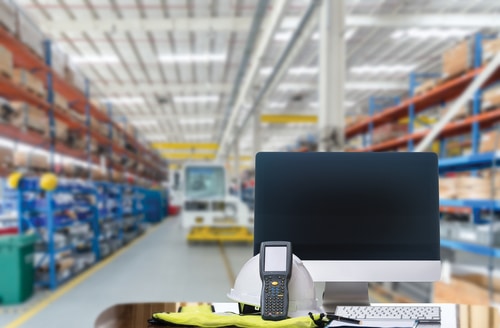
Some of the basic features include:
- Multi-client architecture to support more than one customer
- Efficient costing and invoicing control functionality to process and apply service contract policies in real-time, to facilitate prompt invoicing
- Real-time inventory control and visibility, to nip issues in the bud
- Automated vendor-managed inventory management, to processes and record replenishment requests, aimed at speeding up the supply chain and minimize stock-out situations
- Logistics tracking software, which automatically sends and receive shipping data, to improve accuracy and offering unbridled transparency into cargo movements
- Comprehensive reporting capabilities, with key data such as inventory figures, product histories and shipment records are all accessible remotely at the swipe of a finger or the click of a button, and more.
Smart enterprises go in for inherently customizable and scalable solutions in software and data depositories. While this screams out “cloud,” not all cloud-based tools are equal. Smart players opt for packages or solutions with the right chain management architecture, rather than satisfying themselves with a simple multi-client deployment model.
Good Logistics Management Software Facilitates Seamless Integration
While there are several stand-alone and off-the-shelf software for essential functions related to logistics, today’s highly competitive and integrated business ecosystem requires either a single comprehensive suite covering all these activities or seamless integration between the various stand-alone suites.
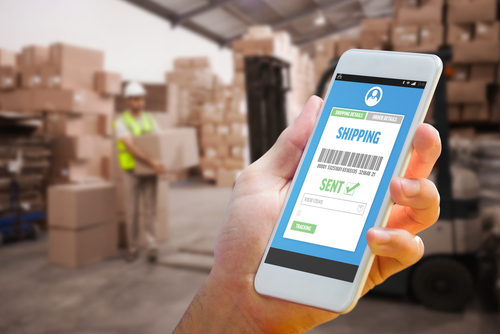
The requirements of integration extend to the ecosystem. There would hardly be any enterprise handling the entire gamut of its logistics operations, end-to-end. Outsourcing is the norm, and striking strategic alliances with competent partners is an established industry best practice and a source of competitive advantage. Many enterprises partner with 3PL companies, who in turn work closely with mainstream parcel carriers such as FedEx and UPS. The smoother the interactions with such partners, the more productive the business.
The best logistics management software requires the capability to tap into the software of all these 3PL and other partners, draw critical information from it, subject it to analytics, and present it to the stakeholders in the form of actionable information.
For instance, seamless logistics requires smooth integration of the software managing warehouse operations and logistics tracking software to the ERP suite of the enterprise, enabling decision-makers and managers to sync and plan inventory and product movement between the warehouse and the store. State-of-the-art automated logistic management software automates such a function, scheduling warehoused dispatches in sync with the movement of the cargo through the supply chain, to avoid stock-out situations. Likewise, it may schedule a slowdown of production if the cargo is blocked at some point in the supply chain, to reduce inventory glut or warehouse over-capacity situations.
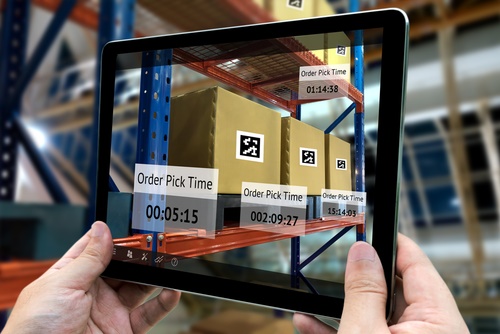
Success, however, depends on a caveat. Businesses would need to resolve the traditional aversion many businesses have, to share too much information with third-party providers, regardless of whether they are business partners in noncompeting businesses and part of the same supply chain or not.
Logistics Tracking Software Goes Beyond Offering Visibility to Aid Tactical Planning
The core of any logistics software is warehouse operations management. Likewise, logistics tracking software offers visibility and helps maintain control of the supply chain. Success depends on a well-integrated logistics software solution, integrating all these critical solutions, and deliverable to the right stakeholders in easy to use dashboards, preferably through mobile apps that facilitate anywhere, anytime access.
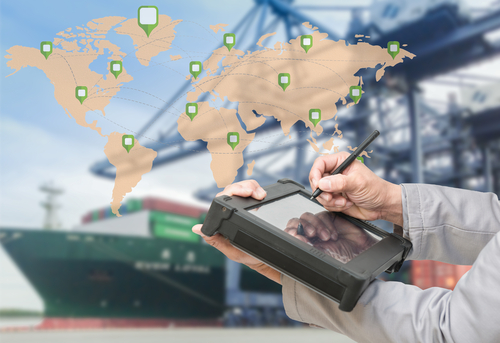
However, mere visibility is no longer enough in today’s hyper-competitive age. Visibility must be combined with insights on what to do next, and here Big Data analytics step in. Embedded analytics is much in demand among today’s successful logistics players.
As the business becomes more complex, the nature of the data also becomes more complex, necessitating the deployment of advanced analytical tools. The best analytics tool separates the wheat from the chaff, to pick out the relevant and timely information from the data corpus, subjects it to analytics, and presents it to the stakeholders in the form of actionable information. For instance, a consistent delay in shipment delivery over a period may be a signal to change the logistics route, or the logistics partner. An ordinary logistics tracking solution would make explicit the delay, but integration with the analytical solution would enrich the insight with possible solutions, such as quotes from other providers, alternative viable routes, or any other solution. Today’ system goes beyond ironing out chinks in the armor but also become a valuable tool in tactical planning.
Good Logistics Software Solutions do not Rock the Boat

Logistics providers would do themselves a favor by having clear-cut objectives when implementing their logistics management software. Legacy providers would do well to devise a system least disruptive to their existing operations, for otherwise they would be saddled with the additional headache of managing resistance to change, a situation underestimated by most enterprises. Always review each feature of functionality in terms of why it is needed, the benefits it brings to the table, and the issues or problems it would solve. Also, have a blueprint of how the new system of functionality will gel in with the logistics operations.
Several off-the-shelf software offers valuable add-ons, such as industry research and peer-to-peer events. Nothing prevents custom software developers to co-opt such features, but the keywords are relevance. The hallmark of a good software is not an extended bucket list of features or functionality, but the extent to which the relevant features are co-opted, and implemented in a non-obtrusive way to the smooth functioning of the enterprise.
Developing and deploying a robust logistics management software is well-nigh impossible in-house for logistics firms, as their core competence and focus are elsewhere. Implementing a brand-new logistics system isn’t a cheap affair either. To get maximum bang for the buck, logistics firms are better off roping in the services of a reliable and competent tech partner who has experience in delivering cutting edge solutions.
Stay up to date on what's new

Featured Blogs
Stay up to date on
what's new



Talk To Our Experts
The noted English poet A L Tennyson’s words “Let the great world spin forever down the ringing grooves of change” captures the impact railways and locomotives brought about in the 19th Century, transforming the world from a grouping of feudal villages to an interconnected urban and industrialized world. Today, the world is in the throes of yet another mobility induced revolution, propelled by artificial intelligence, IoT and a myriad of other technologies that promote convergence and connectivity. This new disruption will be just profound, and likely to change lives forever.
A portent of things to come is Venture investors placing $5.7 billion into transportation businesses in 2016, twice the level of investment in the previous two years combined. The big thing in transportation that happened during the period, Uber and its cousins such as Lyft and GrabTaxi would seem rudimentary compared to the technologies on the anvil.
Autonomous Vehicles
Think artificial intelligence, and the first thing that pops up into most minds is the driverless car. Autonomous vehicles, which facilitate hands-free and feet-free driving are soon set to go mainstream. What works in favor of such vehicles is the ever decreasing cost of production. LiDAR laser sensors that Google uses on its autonomous vehicles cost $70,000 three years ago, it now costs just 10% of this amount now. New technologies now cost even less.
The opportunities that arise from autonomous vehicles are endless. Improved fuel efficiency and greater safety owing to the elimination of “human error” from the equation are the direct benefits, but the indirect benefits are much more. Autonomous cars can plot the best route to the destination, saving time and money, and deliver freedom from traffic jams. Cities can reclaim public spaces devoted to parking. The smaller mass and weight of the autonomous cars enable propulsion by compact, efficient, and environmentally friendly powertrains, reducing energy consumption considerably.
Collaborative Consumption
Collaborative consumption brings most of the benefits of the cloud to the mobility space. Instead of investing in owning and maintaining a vehicle, technology makes it increasingly viable to rent a vehicle on demand, hassle-free, and reliable.
The fleet of autonomous, shared vehicles, fully integrated to the road infrastructure and connected to the internet will create incredible value.
At a macro level, the automobile market is worth $20 trillion, but the utilization rate of this asset class is just 4% to 5%. Uber-inspired on-demand mobility technology would increase efficiency to a potential 10% utilization and at the same time considerable capital which can be diverted to other productive uses.
At the individual level, users are free of the hassles of maintaining the vehicle, navigating traffic, speeding tickets, finding parking space, charging or fuelling up the vehicle, and several other non-productive tasks, time which they can put to better use realizing their core competency.
From a business perspective, the simultaneous rise of fully autonomous networks of long-haul trucks can operate for extended time periods, covering longer distances, with lower costs. The direct benefits are quicker deliveries and decreased costs.
There would be direct cost savings as well. As collaborative consumption gain traction, average costs per passenger mile is expected to dip from around $1 per mile today to about 30¢ per mile.
Revamped Public Transportation
The rise of autonomous vehicles and connected vehicles would also revamp and revolutionize public transportation as we know it today. The sci-fi take “Beam me up, Scotty” may just become closer to reality as individuals can access a reliable, fast and transportation at just a few swipes of their smartphones and get to their destination in the most comfortable, fast, and cost-effective way possible.
Uber-like solutions for public transportation, combined with autonomous vehicles, would mean public transport vehicles becoming flexible enough to cater to real-time demands of mobility, rather than individuals being forced to adapt to timings of public transportation.
Fully autonomous cars, accessible on demand, anytime, anyplace, would make last-mile connectivity hassles a thing of the past, and would in many cases deliver seamless end-to-end transportation in a single vehicle, putting an end to public busses and trains.
As seamless multimodal transportation becomes the new norm, commuters would achieve seamless interoperability, enabling them to reach their destination using multiple, connected modes of transportation, on a single fixed price charged on a single payment system, with minimal walking and wait times. The integration of robotics to the mix may also allow them to travel hands-free, as their luggage, be it files or handbag reaches the same destination at the same time, through its own route.
Efficient Multimodal Network Solutions
Several start-ups are already working to improve transparency and reduce friction in public transportation. Some of the methods already popular include crowdsourcing transit data, moving ticketing to the smartphone, and calculating prices for multiple trip options. Infusing artificial intelligence to make predictive analysis, linking IoT data to automatically calculate the demand for routes, and more are rich possibilities for the future.
A case in point is the Caltrain, the fastest and most cost-efficient way to travel between San Francisco to San Jose. The trip, however, involves long wait times and cumbersome schedules. Effective integration of data from users’ calendars, user’s geo-location, and travel preferences would allow smart apps to plan highly efficient trips, using real-time data. Integrating such data with sharing services extending from cabs to e-bikes offers an effective solution to “last mile” challenges as well.
At the backend, technology would be put to increasing use to develop and manage the vehicle-operating and traffic network information system that helps direct and control the movement of autonomous vehicles and shared mobility fleets.
In the new scheme of things, enterprises that can capture aggregate, and analyze mobility-related data in real time can aspire to gain a foothold in the “virtual” value chain. Enterprises would do well to forge a strategic partnership with tech solution provider companies who have the talent and the expertise to deliver cutting-edge solutions that allow businesses to stamp their digital competency so essential for success. We have the right talent and wealth of experience to serve your needs well.
Stay up to date on what's new

Featured Blogs
Stay up to date on
what's new



Talk To Our Experts
Digital technologies have permeated and disrupted almost all sectors, and logistics companies are no exception.
Optimization and efficiency, combined with speed and seizing the moment are the keys to success in today’s highly competitive advantage. Technology is the key enabler allowing companies to realize these aspects.
Leveraging Technology for Strategic Planning
A report by transport and logistics analysts Oliver Wyman reveals transportation and logistics companies increasing revenue, yet having reduced profits, over a 10-year period, and come with the recommendation to “standardize and streamline structures and processes, developing industry oriented and innovative solutions, thinking and acting in terms of networks.” Technology is the key enabler in this regard.
On average, transportation companies invest about 5% of their annual revenues in digital operations, with the main focus on digitizing their customer interface. The thrust these days is especially on mobile apps and solutions, to offer a personalized experience for their customers, and track the movement of vehicles accurately. However, side-by-side companies are also increasingly using digital technology to unlock new business models, focused on the creation of value-added services and innovative solutions.
The Use of Big Data to Improve Operations
The need to cut cost and take real-time action, in a competitive environment where margins are wafer thin, require logistics companies to take greater control over their supply chain and ensure the processes take place seamlessly, at great speed. Towards such ends, logistics companies are increasingly applying Big Data technology, to capture and analyze data, to streamline their operations and optimize the supply chain.
Computers apply algorithms to crunch Big Data, unlocking insights and opportunities not possible before. Such insights enable streamlining operations and optimization of the supply chain.
- Data based automation, especially automated load building and optimizing the inbound and outbound movement of cargo, enable optimal usage of available resources, reduction of waste, and facilitate lean operations.
- Effective real-time fleet management solution facilitates “uberization” of trucks and other delivery vehicles, where empty containers may be utilized immediately by matching it to the nearest load. Mobile solutions enable greater transparency into the operations.
- A comprehensive data based inventory and supply chain management system unlocks silos, and facilitates end-to-end visibility to inventory, orders and shipments across the supply chain. Such transparency allows improved tracking of inventory movement, facilitates the reduction of network-wide inventory levels, and enable managers to respond dynamically and in real-time to any events or issues that disrupt or hinder the supply chain.
- Analytical data makes explicit greenhouse emissions and carbon footprints of truck and machinery operations, allowing companies to take steps to become carbon-neutral, thereby contributing to the cause of “Green logistics.”
- The combination of machine learning with supply chain management enables turning reams of passive data into actionable business intelligence. Logistics companies apply the wealth of data related to the movement of their goods and trucks to identify patterns related to customer trends, identify what works well, unearth market insights, and gain competitive advantage.
Digital Improves Security
Supply chain disruption is the number one global business risk for logistics companies. Technology enables fortifying the supply chain in many ways.
- Digital locks make the inventory more secure, offer a robust layer of security, in addition to physical security.
- Optimal route planning, combined with real-time tracking of cargo movement through mobile apps enable routing of cargo by avoiding congestion points and trouble spots, to minimize risks and interruption.
Internet of Things (IoT) Enhances Operations
The earliest applications of RFID and nascent IoT technology have been in asset tracking and warehouse management. For instance, rather than simply tracking inventory of pallets and crates, enterprises use sensors, beacons, RFID and other technology to gather information on the state of the connected item, such as when the “thing” requires maintenance, the expected life of the “thing,” and more.
IoT contributes to highly integrated warehouse management solutions, enabling precision movement and accurate tracking of movement of goods. The applications of IoT instruments in logistics are virtually endless, ranging from tracking transportation goods in a temperature controlled way to ensuring the correct package reaches the correct location at the specified time and more.
The trends in the immediate future include connected and ‘autonomous’ trucks, warehouse robotics, and smart warehouse solutions, all of which will improve efficiency manifold, speed up operations, and improve accuracy.
Technological Innovations Unlock New Possibilities
Logistics companies use technology not just to improve efficiency of operations, but also transform the way operations take place in itself. The use of robots in large warehouses, and to handle hazardous goods is already widespread, as is the driverless, remote-controlled vehicles.
The next big thing is the use of drones, especially for last mile delivery. The U.S. Government is already piloting a drone-based traffic monitoring system. Countries such as Spain, France, and The Czech Republic and others have several research projects looking into the use of drones for traffic management. The widespread use of drones would speed up things considerably, reduce the hassles, strain and inefficiency associated with maintaining an army of delivery boys, and also reduce costs considerably.
A start has already been made, with Amazon Prime Air already making legit deliveries using drones, in less than 30 minutes from the time customers place an order. When the technology becomes widespread, logistics will change like never before.
Improved Customer Satisfaction
Proactive transportation and logistics companies go beyond improving their operational efficiency and retaining greater control over their operations, to enhance customer satisfaction.
Technology propels a shift to a customer obsessed operating model, enabling the delivery of personalized and customer-focused logistics, with faster cycle times.
Hyper-connectivity facilitates not just big data, but also speed data. Speed and timeliness, manifesting in seizing the moment enable companies to match customer expectations and deliver competitive differentiation over its competitors.
It requires considerable expertise in both business operations and the latest cutting edge technology to roll out successful technological solutions acceptable by the rank and file. By partnering with us, you can piggy-bank on our vast and extensive experience in delivering highly intuitive apps and other solutions for transportation and logistics firms. Our rich talent pool, combined with extensive experience allow us to add value to your strategy, and roll out seamless apps that make your processes highly efficient, allowing you to cut costs, unlock new possibilities, and take customer satisfaction to new levels.
Stay up to date on what's new

Featured Blogs
Stay up to date on
what's new



Talk To Our Experts
Field service businesses are trying to capitalize on the advantages offered by today’s technologies. Mobile technology, being the most significant among them, has taken the industry by storm, offering increased productivity gains, streamlines work processes, improved field agent communications, increased first-time fix rate, shortened billing cycles, reduced overhead of paper-based field service management and so on. The infographic puts together some recent trends, impacts and state of mobile technology in Field Service Businesses.
Interested in learning more on enabling your field team with mobile technologies? We’d love to know your business requirements and help accordingly, contact our specialist team now.
Share this Infographic On Your Site
Stay up to date on what's new

Featured Blogs
Stay up to date on
what's new

















